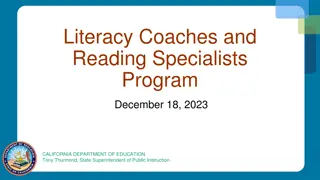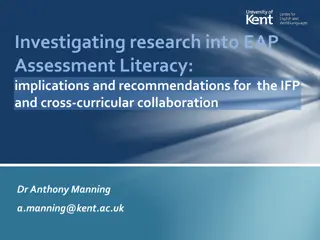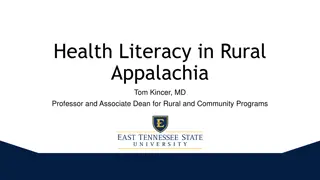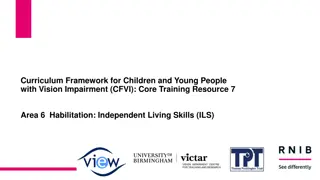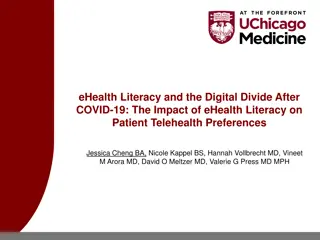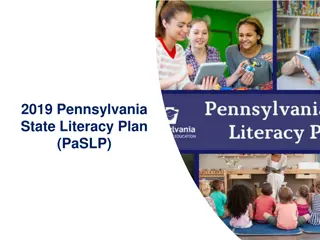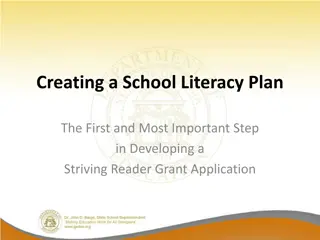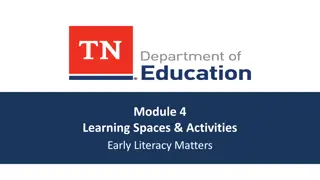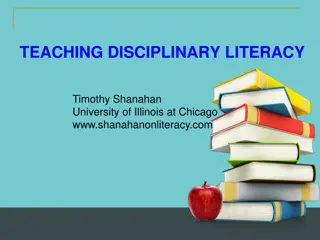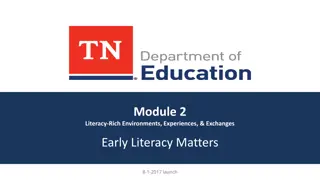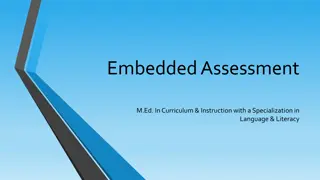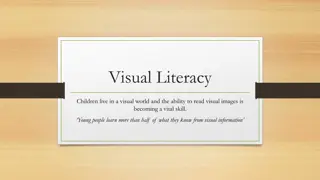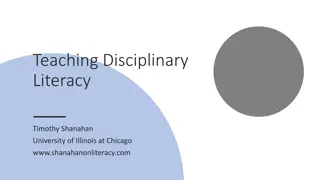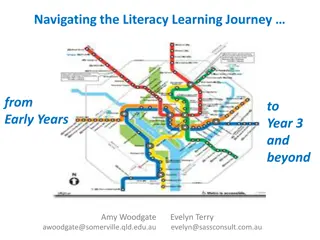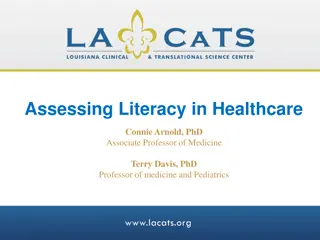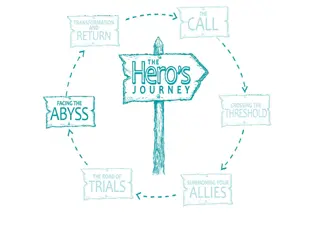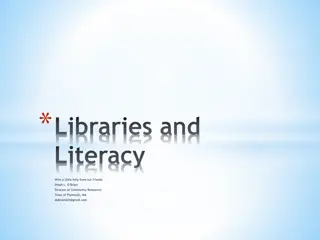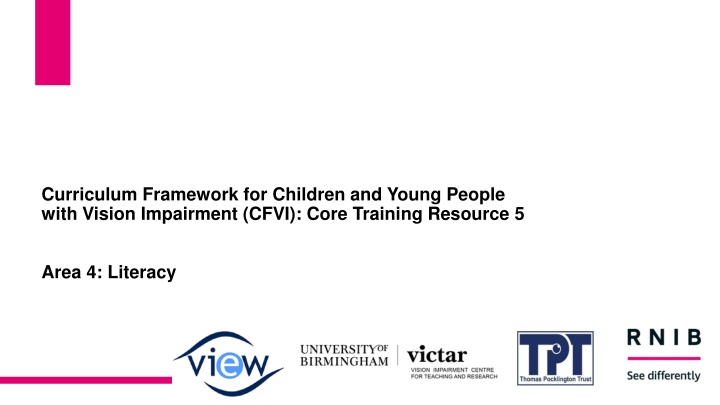
Training Resource for Children and Young People with Vision Impairment
Explore the Curriculum Framework for Children and Young People with Vision Impairment (CFVI) core training resource focusing on literacy. Understand the importance of literacy for learners with vision impairment, specialist strategies, key stakeholder roles, and valuable resources. Discover inclusive strategies and potential barriers to access in educational settings.
Download Presentation

Please find below an Image/Link to download the presentation.
The content on the website is provided AS IS for your information and personal use only. It may not be sold, licensed, or shared on other websites without obtaining consent from the author. If you encounter any issues during the download, it is possible that the publisher has removed the file from their server.
You are allowed to download the files provided on this website for personal or commercial use, subject to the condition that they are used lawfully. All files are the property of their respective owners.
The content on the website is provided AS IS for your information and personal use only. It may not be sold, licensed, or shared on other websites without obtaining consent from the author.
E N D
Presentation Transcript
Curriculum Framework for Children and Young People with Vision Impairment (CFVI): Core Training Resource 5 Area 4: Literacy
Project Partners There are 4 partner organisations involved in the CFVI project. The production of these training/continuing professional development materials was led by VIEW (The Professional Association for the Vision Impairment Education Workforce), in association with a consultation group of stakeholders working in the field of VI Education.
Curriculum Framework for Children and Young People with Vision Impairment (2022, p.15)
Training Objectives (1) The objectives of this training resource are to: provide an introduction to Area 4 of the CFVI: Literacy. examine why a focus on this area is important for learners with vision impairment. outline some specialist strategies and teaching approaches. examine the role of key stakeholders in supporting the development of literacy. provide some links to useful resources/websites.
Training Objectives (2) Customisable slide if needed (see notes for the previous slide which give examples of training objectives that you could consider, depending on the nature of your presentation).
Identifying potential barriers to access (1) Situation What does vision tell the child in this situation? A child without a VI listening to a class story. how pictures supplement the content of the story and aid understanding. information about colour, shape and space. details of the font and size of the print. where their peers are sitting in the Story World area. where the teacher is sitting. what the book looks like. what other books are on the shelves in the Story World area. where their peers are in relation to themselves. the body language of those around them: social cues ? The children are sitting down on cushions in a multisensory area of the classroom called Story World .
Identifying potential barriers to access (2) Situation Inclusive strategies to reduce barriers to learning ? ? ? A child with a reduced distance vision listening to a class story. The children are sitting down on cushions in a multisensory area of the classroom called Story World .
Identifying potential barriers to access (3) Situation Inclusive strategies to reduce barriers to learning ? ? ? Add here Add here
Why is a focus on this area important? (1) Literacy underpins the entire curriculum for all CYP. Literacy can be very visual experience based - incidental learning is reduced for children with VI, so less opportunity to see letters/ words in their surroundings. Vision impairment creates potential barriers to the development of key concepts. Potential barriers to access can be reduced through promoting accessible learning environments (Area 1) and use of targeted intervention approaches (Area 4).
Why is a focus on this area important? (2) With reference to a selected education environment list some potential barriers vision impairment may create for a child/young person in accessing literacy. For each barrier, identify ways in which we could adapt this environment to reduce the barrier and promote greater access to literacy.
About this area: Literacy This area of the framework recognises the importance of working with children and young people to develop their literacy skills and promote accessible learning environments. Examples include specialist adjustments and approaches to teaching, environmental adaptations, adopting alternative or bespoke approaches, codes and technology. A QTVI has an important role in delivery of specialist teaching, facilitating collaboration and guiding decision-making in relation to a child/young person s literacy pathway.
About this area: Examples of literacy pathways Literacy through print (e.g. large print). Literacy through braille (braille reading; braille writing). Literacy through alternative tactile codes (e.g. Moon code). Literacy through symbols (e.g. tactile/visual symbols). Literacy through speech technology (e.g. switches, screen readers).
Literacy pathway plan for (name of child/young person) Name of child Nature of vision impairment. What we did - past access needs. What we are doing - current access needs. What we plan to do - future access needs.
Examples of targeted intervention approaches for Area 4 listed in CFVI to reduce barriers (1) A clear and developing literacy pathway plan, informed by assessment. Literacy through print: Optimising print presentation. Use of low vision devices. CCTVs / electronic magnification. Mainstream electronic equipment, e.g. tablets, interactive class whiteboards through use of a monitor or screen mirroring. Specialist magnification software. Training in speed reading. Providing real life and concrete experiences to develop concepts.
Examples of targeted intervention approaches for Area 4 listed in CFVI to reduce barriers (2) Literacy through braille. Literacy through Moon. Literacy through sensory stories, pictures and object symbols. Speech technology. Writing and use of appropriate technology: braille specific technology, computer, pen, dictation software. handwriting, developing an appropriate handwriting style which aids legibility. touch typing and computer access skills.
Why a focus on this area is important for (name of child/young person); what interventions are in place? Details of pupil s vision impairment. How it influences their access to the curriculum/social interactions. What interventions are in place to promote literacy development? What are the envisaged outcomes? Who delivers/works on these outcomes?
Summing up Vision impairment creates distinctive barriers to access, learning and participation for children and young people. Targeted intervention approaches within inclusive learning environments (See CFVI, Area 1) are required to promote effective literacy development. Collaborative working with the child/young person, family and educators is required to maximise the use and development of their literacy skills. An understanding of how the specialist skills needed relate to phase of learning and curriculum being taught at is crucial to ensure student independent literacy skills are developed to support progress in all curriculum areas.
What resources are available The Bookshare Hub hosting resources to support the delivery of the CFVI is available from the RNIB (External) Of particular relevance to this area is the Literacy category of the CFVI Resource Hub The CFVI provides a list of targeted intervention approaches (page 22): Curriculum Framework for Children and Young People with Vision Impairment | RNIB
References Hewett, R., Douglas, G., McLinden, M., James, L., Brydon, G., Chattaway, T.,Cobb, R., Keil, S., Raisanen, S., Sutherland, C., Taylor, J., (2022) Curriculum Framework for Children and young People with Vision Impairment[CFVI]: Defining specialist skills development and best practice support to promote equity, inclusion and personal agency. RNIB

